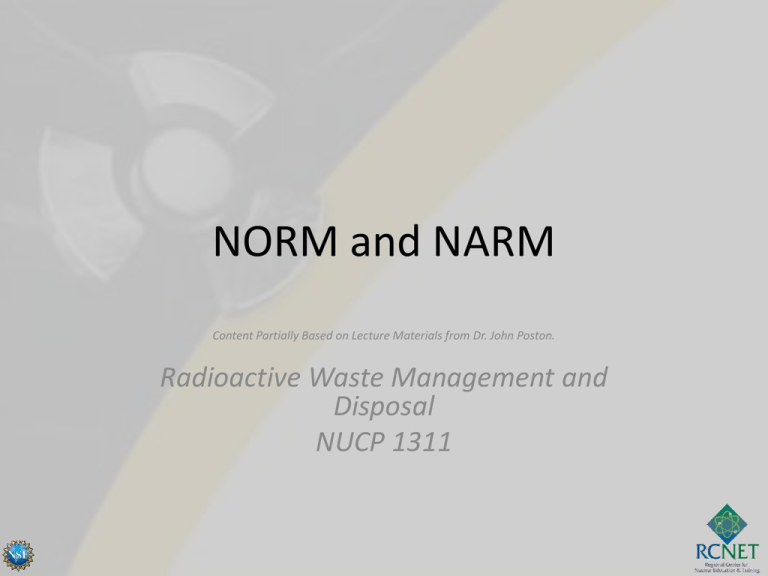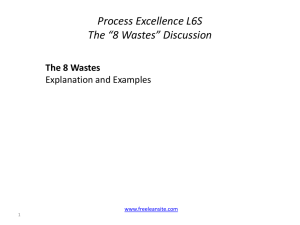NORM and NARM
advertisement

NORM and NARM Content Partially Based on Lecture Materials from Dr. John Poston. Radioactive Waste Management and Disposal NUCP 1311 Objectives • Define NORM and NARM wastes • Discuss sources of these wastes, generation rates, and total activities of each • Look at one process as an example of man’s activities Comment • It is sometimes very difficult to define the dividing line between materials that contribute to the “technologically-enhanced natural radiation environment” (TENRE) and the wastes classified as NORM and NARM TENRE • “…. exposures to truly natural sources of radioactivity which would not occur without (or are increased by) some technological activity not expressly designed to produce radiation.” UNSCEAR http://www.unscear.org/unscear/index.html NORM • Naturally Occurring Radioactive Material – materials not covered in the Atomic Energy Act whose radioactivity has been enhanced (i.e., materials whose radionuclide concentrations are either increased or redistributed compared to typical background levels either naturally or as the result of human intervention or processes). NARM • Naturally occurring or Accelerator produced Radioactive Material – any radioactive material that can be considered naturally occurring and is not source, special nuclear, or by product material, or it is a radioactive material produced in a charged particle accelerator. Naturally Occurring Radioactive Material (NORM) • Results from the concentration of naturally occurring radionuclides found in the earth’s crust • Classified as: – Discrete wastes – Diffuse wastes NORM • Discrete wastes have relatively small volumes but large radioactivity – Industrial gauges – Radium watches and clocks – Radium needles (medical applications) – Resins to remove radium and other NORM from ground water NORM • Diffuse wastes have relatively large volumes but small radioactivity – Coal ash and slag – Solid wastes from geothermal activities – Wastes from mining and processing for other metals (e.g., copper) – Sludge from drinking water treatment – Scale, etc. from oil and gas production – Wastes from mining phosphate ores U-235 Chain Th-232 Chain Consumer Products • • • • • • Radioluminous products Electronic and electrical devices Antistatic devices Smoke and fire detectors Ceramics and U-Th alloys Other products, i.e., scientific instruments Discrete Wastes • Radium dial watches: 0.1 – 3 Ci • Instrument dials: ~ 20 Ci • In 1977, ~ 8.4 million radium-bearing timepieces were in use in the U.S. • According to UNSCEAR, radium dials have not been manufactured since 1966 Diffuse NORM Wastes • Major radionuclides include: – – – – – U-234, 235, 238 Th-228, 230, 232 Ra-224, 226, 228 Pa-231, Ac-227, Rn-222 Po-210, Pb-210, K-40 • Annual generation rate – 1.1 x 109 tons/y • Total mass - 60 x 109 tons* • Total activity - ~ 5 x 106 Ci* * Represents the total inventory Combustion of Coal • Contains U, Th, Ra, and their daughter products as well as 14C • Products of combustion are called “bottom ash,” “boiler slag,” and “fly ash” • Consists mostly of Al, Fe, Ca, and Si • Concentrations in coal vary with mining location and region – Coal in western states (Wyoming, Idaho and Montana) contains much higher concentrations of uranium – Concentrations several hundred ppm compared to 10 ppm in eastern coal Diffuse NORM Wastes • Radionuclides found in coal combustion wastes: – U-234, 235, 238, Pa-231, Ac-227, Po-210 – Th-228, 230, 232, Ra-226, 228, Pb-210 – Concentration in fly ash ~ 27 pCi/g – Concentration in slag ~7 pCi/g Coal Combustion Wastes • Annual generation rate – Bottom ash & slag – Fly ash 17 x 106 tons/y 44 x 106 tons/y • Total mass – Bottom ash & slag – Fly ash 340 x 106 tons 960 x 106 tons • Total activity – Bottom ash & slag – Fly ash 2,300 Ci 26,000 Ci NORM and NARM – II or is it NARM and NORM? Content Partially Based on Lecture Materials from Dr. John Poston. Official Definitions (EPA Website) • By-product Material – There are basically two types of by-product materials. • The first are produced by a nuclear reactor • The second are produced by the uranium and thorium mining process. – A more precise definition reads: "(1) Any radioactive material (except special nuclear material) yielded in, or made radioactive by, exposure incident to the process of producing or utilizing special nuclear material, and (2) The tailings or wastes produced by the extraction or concentration of uranium or thorium from ore processed primarily for its source material http://www.epa.gov/radiation/mixed-waste/mw_pg5.htm content, including discrete surface wastes Official Definitions (EPA Website) • Source Material – Source Material is the Uranium or Thorium ores mined from the Earth. – Source material is defined in 10 CFR 20.1003 as "(1) Uranium, or thorium or any combination of uranium and thorium in any physical or chemical form; or (2) Ores that contain, by weight, onetwentieth of 1 percent (0.05 percent), or more, of uranium, thorium, or any combination or uranium and thorium. Source material does not include special nuclear material." http://www.epa.gov/radiation/mixed-waste/mw_pg5.htm Official Definitions (EPA Website) • Special Nuclear Material (SNM) – SNM is defined in 10 CFR 20.1003 as "(1) Plutonium, uranium-233, uranium enriched in the isotope 233 or in isotope 235, and any other material that the NRC, pursuant to the provisions of section 51 of the AEA, determines to be SNM, but does not include source material; (2) or any material artificially enriched by any of the foregoing but does not include source material.“ – SNM is important in the fabrication of weapons http://www.epa.gov/radiation/mixed-waste/mw_pg5.htm Official Definitions (EPA Website) • Naturally Occuring or Accelerator Produced Radioactive Materials (NARM) – Radioactive materials not covered under the AEA that are naturally occurring or produced by an accelerator. – Accerlerators are used in sub-atomic particle physics research. These materials have been traditionally regulated by States. – A subset of NARM is NORM. NARM waste with more than 2 nCi/g of 226Ra or equivalent is commonly referred to as discrete NARM waste; below this threshold, the waste is referred to as http://www.epa.gov/radiation/mixed-waste/mw_pg5.htm diffuse NARM waste. NARM Radionuclides • About 50 radionuclides found in NARM. • Range from 11C to 204Bi. • Many radionuclides decay through - or + emission or EC, and IT. • Most have short half-lives (seconds, minutes, days, hours), except for 81Kr (2.1 x 105 y). NARM • Wastes are generally not regulated by the federal government. • Responsibility rests with the states – part of their authority to ensure protection of the public health and safety. • But, some states do not have regulatory programs. Official Definitions (EPA Website) • Naturally Occurring Radioactive Materials (NORM) – NORM is a subset of NARM and refers to materials not covered under the AEA whose radioactivity has been enhanced. – Enhancement means that the radionuclide concentrations are either increased or redistributed where they are more likely to cause exposure to man usually by mineral extraction or processing activities. – Examples are exploration and production wastes from the oil and natural gas industry and phosphate slag piles from the phosphate mining industry. – This term is not used to describe or discuss the http://www.epa.gov/radiation/mixed-waste/mw_pg5.htm natural radioactivity of rocks and soils, or NORM • Naturally Occurring Radioactive Material – materials not covered in the Atomic Energy Act whose radioactivity has been enhanced (i.e., materials whose radionuclide concentrations are either increased or redistributed compared to typical background levels either naturally or as the result of human intervention or processes). Metal Mining & Processing • Wastes include ore tailings and smelter slag (uranium and phosphate wastes excluded). • Typically contains U, Th, Ra and decay products. • Some extraction processes yield waste with higher radionuclide concentrations. • Concentration varies with geologic formation and region. NORM Wastes from Mining and Processing • Rare earth metals – Lanthanide metals – 16 elements • Special application metals – Have unique commercial and industrial uses - Hf, Sn, Ti, Zr • Metals produced in bulk quantities – Bulk industrial applications – Al, Cu, Fe, Pb, Zn, Au, Ag Wastes from Metal Mining and Processing • Generally, the same radionuclides are found in the wastes from metal mining and processing – Rare earth metals – Special application metals – Large-volume industry metals 11,000 pCi/g 305 pCi/g 74 pCi/g • Large bulk metal industries (e.g., copper, aluminum, iron, steel) • Annual generation rate – 1 x 109 tons/y • Total mass - 50 x 109 tons 6 Wastes from Metal Mining and Processing • • • • Rare earths metals (Lanthanides) Annual generation rate – 0.2 x 106 tons/y Total mass - 1 x 106 tons Total activity – 11,000 Ci Municipal Water Treatment • Some water supply systems treat water containing elevated levels of NORM • Radionuclides are leached into ground and surface water • Wastes include sludges and solids – Filter sludges – Ion-exchange resins – Activated charcoal – Radium-selective resins - discrete wastes Diffuse NORM Wastes • The same radionuclides are found in the wastes from municipal water treatment – Sludges – Radium selective resins ~ 72 pCi/g ~ 35,000 pCi/g Geothermal Energy Generation • Using the natural heat, pressure and liquid from within the earth • Hot rock technology also a potential source of NORM • Geysers, CA – Unit No. 18 Wastes from Geothermal Energy Production • Minerals that precipitate out of solution forming scale or sludge on the inside surfaces of equipment • Contain barium, calcium, and strontium salts (carbonates, sulfates, silicates) as well as silica • Contain significant concentrations of radium and radium decay products Diffuse NORM Wastes • Radionuclides associated with geothermal energy production – Th-228 – Ra-228 – Ra-226 – Po-210 – Pb-210 – TOTAL 25 pCi/g 93 pCi/g 132 pCi/g 96 pCi/g 96 pCi/g 442 pCi/g Wastes from Geothermal Energy Production • Annual generation rate – 0.054 x 106 tons/y • Total mass - 0.74 x 106 tons • Total activity – 330 Ci Oil and Natural Gas Production • Are similar to geothermal wastes. • Scale consists of barium, calcium and strontium sulfates, silicates, and carbonates and radium compounds. • Sludge deposits consist of barium and silica compounds – oily and loose. • Activities vary widely. • Annual generation rate – 0.056 x 106 tons/y • Total mass - 4 x 106 tons • Total activity – 1,210 Ci Diffuse NORM Wastes • Radionuclides associated with wastes from oil and natural gas production Scale Sludge Th-228 Ra-228 Ra-226 Po-210 Pb-210 TOTAL 120 pCi/g 120 pCi/g 360 pCi/g 360 pCi/g 360 pCi/g 1,320 pCi/g 19 pCi/g 19 pCi/g 56 pCi/g 56 pCi/g 56 pCi/g 206 pCi/g Phosphate Mining and Fertilizer Production • Wastes generated from the mining and processing of phosphate rock. • Used to produce phosphate fertilizers, detergents, animal feed, food products, pesticides, and other phosphorous chemicals. • Wastes include ferrophosphorous, phosphogypsum, piping scale, and slag. Phosphate Mining and Fertilizer Production • In the U.S., about 150 million tons of rock mined annually. • Florida produces about 91% of the rock • Other states – Tennessee, Idaho, Missouri, Montana, Utah, Wyoming, Georgia, and North and South Carolina. • Contains high concentrations of K, Ra, Th, and U. Phosphate Mining and Fertilizer Production • Both wet (southeastern states) and dry mining (western states) processes are used. • About 12-15 million tons of phosphate fertilizer are produced annually. • Distribution of 120 Ci of Ra-226 annually on agricultural lands. Phosphate Mining and Fertilizer Production • The same radionuclides found in coal are found in phosphate rock • Some concentrations are very uncertain – – – – Ferrophosphorous Phosphogypsum Scale Slag 1.2 pCi/g* 113 pCi/g 1000 pCi/g* 192 pCi/g *A very rough estimate of Ra-226 activity concentration only Activities in Phosphate Rock in the U.S. 226Ra 238U 232Th (pCi/g) (pCi/g) (pCi/g) Tennessee 4 4 0.5 North Carolina 18 26 1 Montana 41 38 0.7 Florida 54 52 1.6 South Carolina 130 130 2.1 State Florida Phosphate Areas Phosphoric Acid and Fertilizer Production Phosphorus Production Summary • NORM Wastes – wide spread – Discrete wastes – Diffuse wastes – Naturally-occurring materials • NARM Wastes – often man-made – Accelerator produced – Accelerator materials – Naturally-occurring materials Questions





